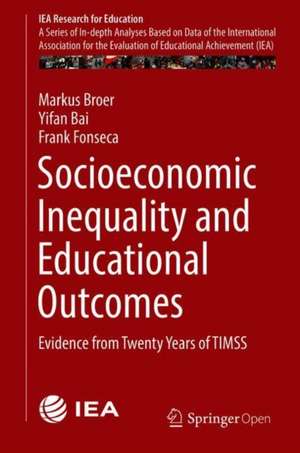Socioeconomic Inequality and Educational Outcomes: Evidence from Twenty Years of TIMSS: IEA Research for Education, cartea 5
Autor Markus Broer, Yifan Bai, Frank Fonsecaen Limba Engleză Hardback – 27 mai 2019
Education systems generally aim to narrow theachievement gap between low- and high-SES students and to improve the performance of disadvantaged students. However, the lack of quantifiable and comprehensible measures makes it difficult to assess and monitor the effect of such efforts. In this study, a novel measure of SES that is consistent across all TIMSS cycles allows students to be categorized into different socioeconomic groups. This measure of SES may also contribute to future research using TIMSS trend data.
Readers will gain new insight into how educational inequality has changed in the education systems studied and how such change may relate to the more complex picture of macroeconomic changes in those societies.
| Toate formatele și edițiile | Preț | Express |
|---|---|---|
| Paperback (1) | 376.43 lei 6-8 săpt. | |
| Springer International Publishing – 14 aug 2020 | 376.43 lei 6-8 săpt. | |
| Hardback (1) | 360.64 lei 38-44 zile | |
| Springer International Publishing – 27 mai 2019 | 360.64 lei 38-44 zile |
Din seria IEA Research for Education
-
 Preț: 361.07 lei
Preț: 361.07 lei -
 Preț: 417.90 lei
Preț: 417.90 lei -
 Preț: 421.72 lei
Preț: 421.72 lei -
 Preț: 362.82 lei
Preț: 362.82 lei -
 Preț: 348.00 lei
Preț: 348.00 lei -
 Preț: 351.88 lei
Preț: 351.88 lei -
 Preț: 291.52 lei
Preț: 291.52 lei -
 Preț: 369.80 lei
Preț: 369.80 lei -
 Preț: 420.02 lei
Preț: 420.02 lei -
 Preț: 360.64 lei
Preț: 360.64 lei -
 Preț: 367.70 lei
Preț: 367.70 lei -
 Preț: 360.34 lei
Preț: 360.34 lei - 16%
 Preț: 299.52 lei
Preț: 299.52 lei
Preț: 360.64 lei
Nou
Puncte Express: 541
Preț estimativ în valută:
69.01€ • 72.06$ • 56.98£
69.01€ • 72.06$ • 56.98£
Carte tipărită la comandă
Livrare economică 11-17 aprilie
Preluare comenzi: 021 569.72.76
Specificații
ISBN-13: 9783030119904
ISBN-10: 3030119904
Pagini: 110
Ilustrații: VIII, 83 p. 39 illus.
Dimensiuni: 155 x 235 mm
Greutate: 0.31 kg
Ediția:1st ed. 2019
Editura: Springer International Publishing
Colecția Springer
Seria IEA Research for Education
Locul publicării:Cham, Switzerland
ISBN-10: 3030119904
Pagini: 110
Ilustrații: VIII, 83 p. 39 illus.
Dimensiuni: 155 x 235 mm
Greutate: 0.31 kg
Ediția:1st ed. 2019
Editura: Springer International Publishing
Colecția Springer
Seria IEA Research for Education
Locul publicării:Cham, Switzerland
Cuprins
1. Socioeconomic Inequality and Educational Outcomes: An Introduction.- 2. A Review of the Literature on Socioeconomic Status and Educational Achievement.- 3. Methodology: Constructing a Comparable Socioeconomic Index for 20 Years of TIMSS.- 4. Socioeconomic Achievement Gaps: Trend Results for Education Systems.- 5. Trends in Socioeconomic Achievement Gaps in the Macroeconomic Context: Discussion and Future Research.- Appendix.- References.
Textul de pe ultima copertă
This open-access book focuses on trends in educational inequality using twenty years of grade 8 student data collected from 13 education systems by the IEA’s Trends in Mathematics and Science Study (TIMSS) between 1995 and 2015. While the overall positive association between family socioeconomic status (SES) and student achievement is well documented in the literature, the magnitude of this relationship is contingent on social contexts and is expected to vary by education system. Research on how such associations differ across societies and how the strength of these relationships has changed over time is limited. This study, therefore, addresses an important research and policy question by examining changes in the inequality of educational outcomes due to SES over this 20-year period, and also examines the extent to which the performance of students from disadvantaged backgrounds has improved over time in each education system.
Education systems generally aim to narrow the achievement gap between low- and high-SES students and to improve the performance of disadvantaged students. However, the lack of quantifiable and comprehensible measures makes it difficult to assess and monitor the effect of such efforts. In this study, a novel measure of SES that is consistent across all TIMSS cycles allows students to be categorized into different socioeconomic groups. This measure of SES may also contribute to future research using TIMSS trend data.
Readers will gain new insight into how educational inequality has changed in the education systems studied and how such change may relate to the more complex picture of macroeconomic changes in those societies.
Education systems generally aim to narrow the achievement gap between low- and high-SES students and to improve the performance of disadvantaged students. However, the lack of quantifiable and comprehensible measures makes it difficult to assess and monitor the effect of such efforts. In this study, a novel measure of SES that is consistent across all TIMSS cycles allows students to be categorized into different socioeconomic groups. This measure of SES may also contribute to future research using TIMSS trend data.
Readers will gain new insight into how educational inequality has changed in the education systems studied and how such change may relate to the more complex picture of macroeconomic changes in those societies.
Caracteristici
Uses 20 years of TIMSS data to investigate educational inequality in a novel way Uses a consistent measure of socioeconomic status (SES) over the 20-year period of TIMSS data Relates trends in educational inequality to the larger macroeconomic context
